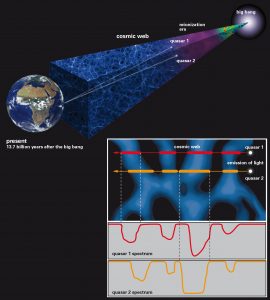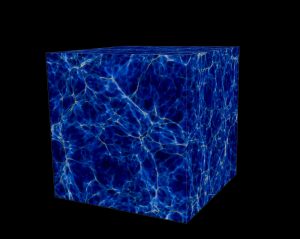Astronomers Measure Ripples in ‘Cosmic Web’ for First Time

Schematic representation of the technique used to probe the small-scale structure of the cosmic web using light from a rare quasar pair. The spectra (bottom right) contain information about the hydrogen gas the light has encountered, as well as the distance of that gas. Photo courtesy of SPRINGEL et al. (2005) (cosmic web)/J. NEIDEL, MPIA.
A team of astronomers has made the first measurements of small-scale ripples in the “cosmic web” using images gathered at W.M. Keck Observatory on Maunakea.
The cosmic web is a vast network of filamentary structures made up of sparse hydrogen atoms left over from the Big Bang. These tangled strands span billions of lights years and contain the majority of the atoms in the universe.
Studying regions of this web some 11 billion light years away, scientists have been able to measure small-scale variations in the structure of this primeval hydrogen gas. The results have been published in the journal Science.
Intergalactic gas is so insubstantial that it reflects no light. Instead, astronomers study it indirectly by observing how it absorbs light from faraway sources called quasars.
Quasars represent a brief, hyper luminous phase of the galactic life-cycle powered by matter pouring into a galaxy’s central black hole. They act like cosmic lighthouses, emitting distant beacons of light that allow astronomers to study atoms residing in the vast stretches of space between the quasars and Earth.
Because quasars represent only a brief, tiny fraction in the span of a galaxy’s life, they are extremely rare in the sky and typically lie hundreds of millions of light years apart.
To measure the ripples in the tenuous cosmic web using quasars, astronomers used their expertise coupled with a fortuitous cosmic coincidence. They identified exceedingly rare pairs of quasars situated near one another in the night sky, and measured subtle differences in their absorption of intergalactic atoms observed along the two lines of sight.
“Pairs of quasars are like needles in a haystack,” explained Joseph Hennawi, an associate professor at University of California Santa Barbara’s Department of Physics. “In order to find them we combed through images of billions of celestial objects, millions of times fainter than what the naked eye can see.”
Hennawi pioneered the use of algorithms from ‘machine learning’–a branch of artificial intelligence–to efficiently find quasar pairs in the massive amounts of data produced by digital imaging surveys of the night sky.
Once identified, the quasar pairs were observed with the largest telescopes in the world, including the 10-meter telescopes at the W. M. Keck Observatory on Maunakea, Hawai‘i. At Keck, a majority of the data was gathered using the Low Resolution Imaging Spectrometer (LRIS), a faint-light instrument on the Keck I telescope capable of taking spectra and images of the most distant known objects in the universe, along with the Echellette Spectrograph and Imager (ESI) on Keck II to capture high-resolution spectra of the rare quasar pairs.
“One of the biggest challenges was developing the mathematical and statistical tools to quantify the tiny differences we measured in this new kind of data,” said lead author Alberto Rorai, Hennawi’s former PhD student, who is now a postdoctoral researcher at Cambridge University. Rorai developed these tools as part of the research for his doctoral degree, and applied them to spectra of quasars obtained with Hennawi and other colleagues.

Volume rendering of the output from a supercomputer simulation showing part of the cosmic web 11.5 billion years ago. This and other models of the universe were generated and directly compared with quasar pair data in order to measure the small-scale ripples in the cosmic web. The cube is 24 million light years on a side. Photo courtesy of J. Onorbe/MPIA.
The astronomers compared their measurements to supercomputer models that simulate the formation of cosmic structures from the Big Bang to the present. Using a consumer-grade laptop, these complex calculations would have taken nearly 1,000 years to complete. But modern supercomputers enabled the researchers to carry them out in just a few weeks.
“The input to our simulations are the laws of physics and the output is an artificial universe, which can be directly compared to astronomical data,” said co-author Jose Oñorbe, a postdoctoral researcher at the Max Planck Institute for Astronomy who led the supercomputer simulation effort. “I was delighted to see that these new measurements agree with the well-established paradigm for how cosmic structures form.”
“One reason these small-scale fluctuations are so interesting is that they encode information about the temperature of gas in the cosmic web just a few billion years after the Big Bang,” explained Hennawi.
Astronomers believe that the matter in the universe went through phase transitions billions of years ago, which dramatically changed its temperature. These phase transitions, known as cosmic re-ionization, occurred when the collective ultraviolet glow of all stars and quasars in the universe became intense enough to strip electrons off atoms in intergalactic space.
How and when re-ionization occurred is one of the biggest open questions in the field of cosmology, and these new measurements provide important clues that will help narrate this chapter in the history of the universe.














